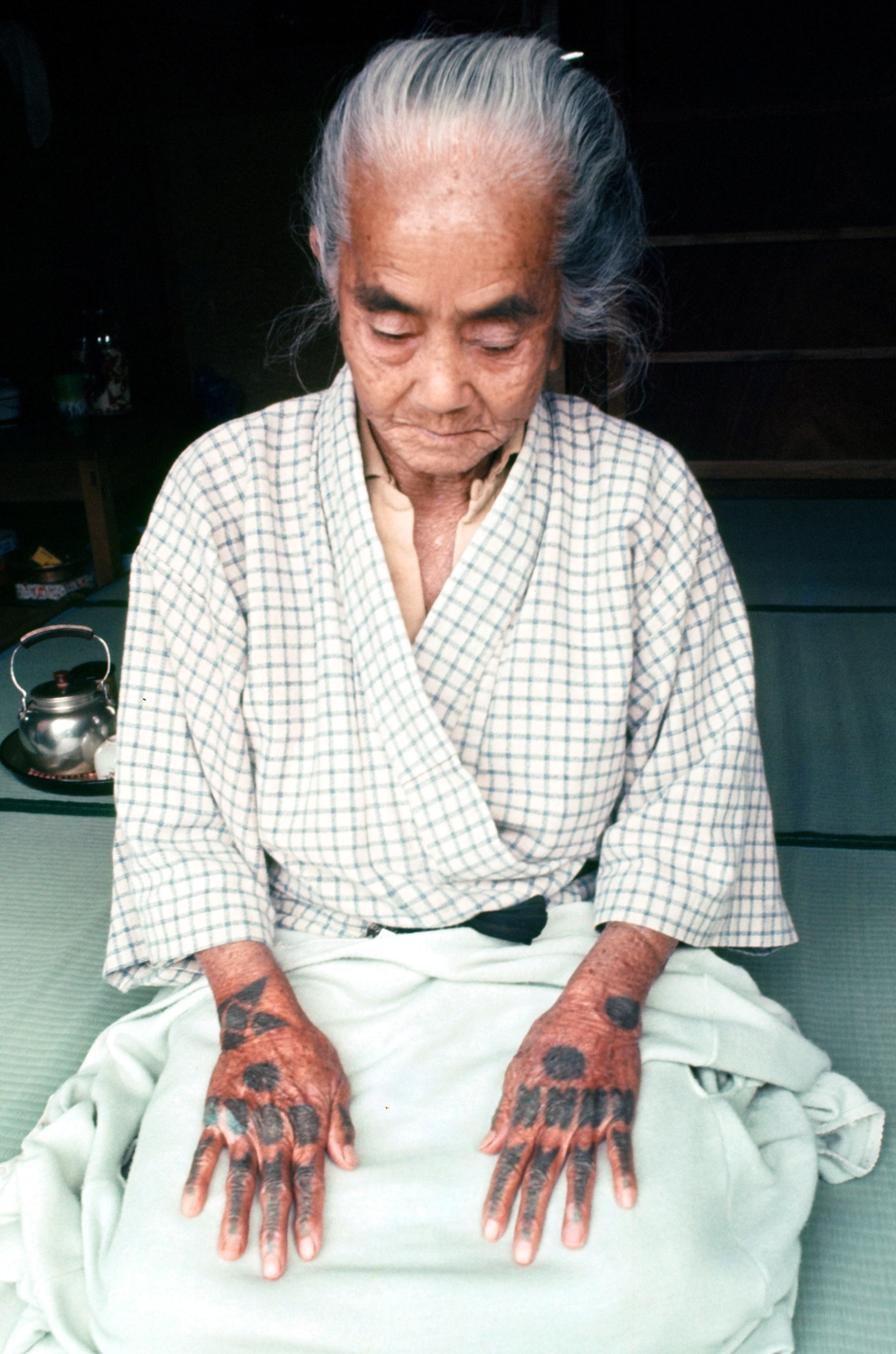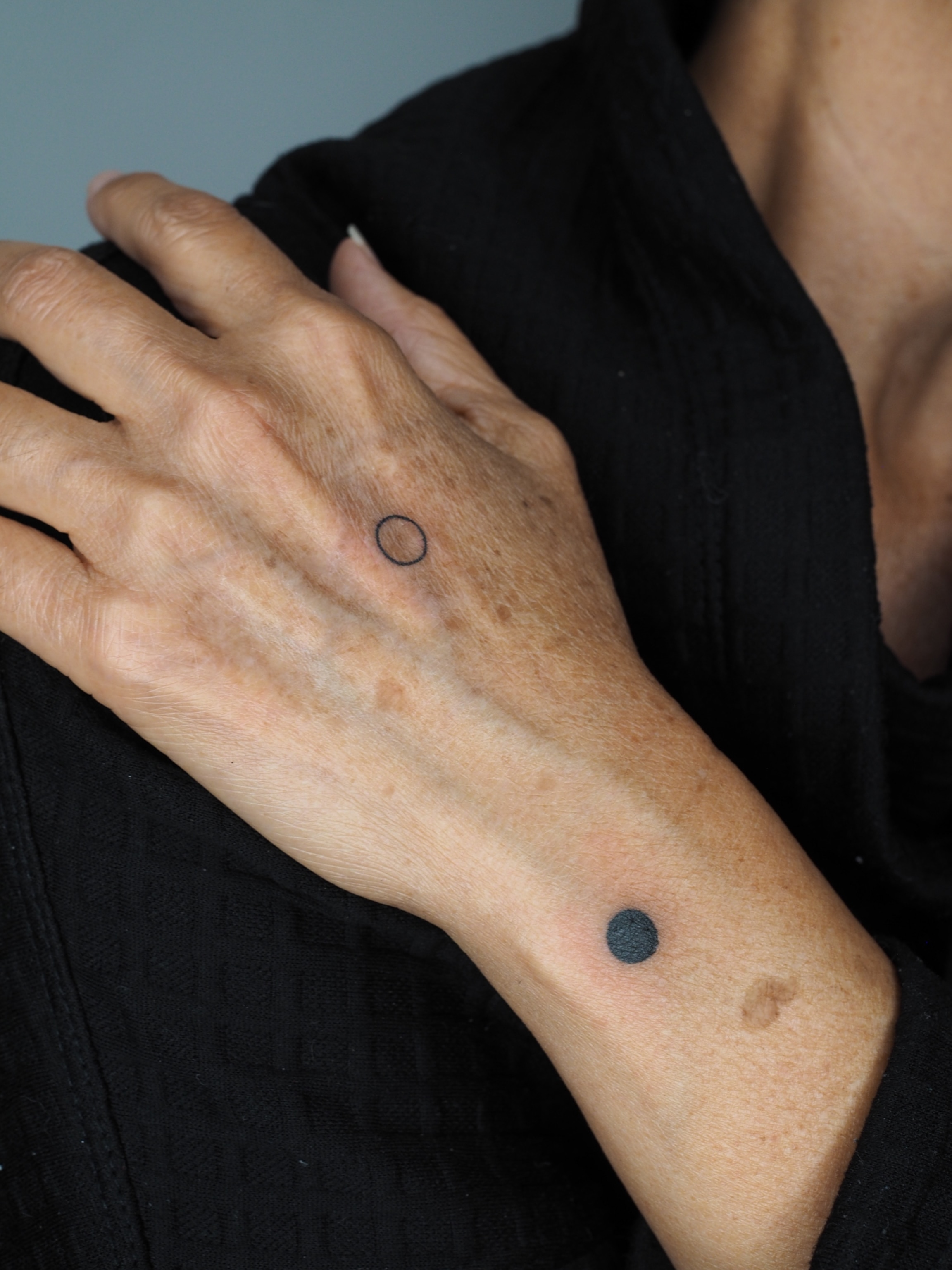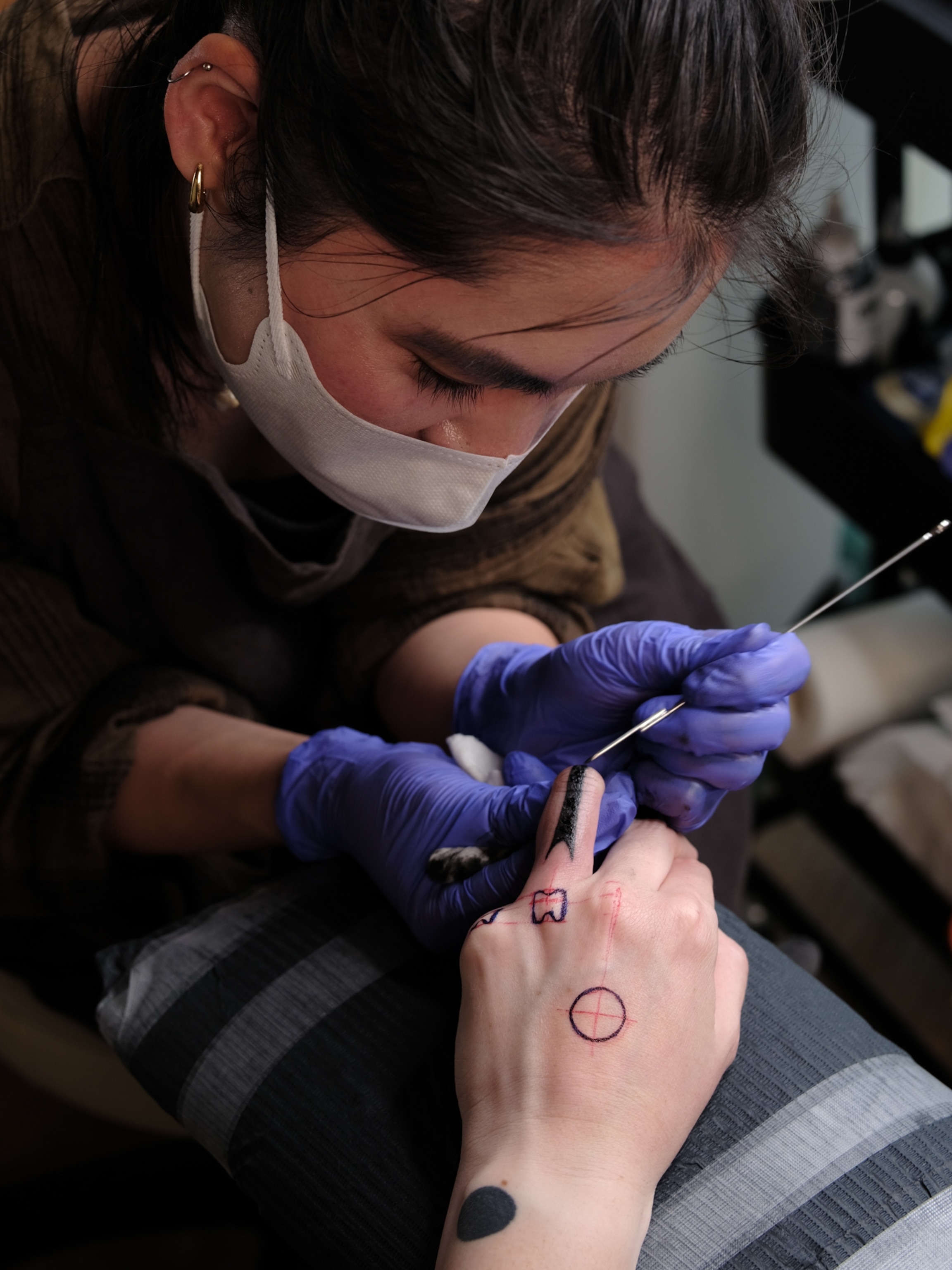Inside a small tatami room just outside the center of Naha, the capital of Okinawa Prefecture, a quiet rebirth of a once-banned tattoo practice is taking place. Moeko Heshiki, one of the few remaining hajichaas, lays out her stick-and-poke tools with practiced care. My eyes are drawn to the long, dark arrows that trace the length of her fingers—a sacred art now nearly lost.
I tell her that the last woman in my lineage to have hajichi tattoos was my great-great-grandmother, the weight of both pride and loss settling over me.
“People sometimes tell me, ‘Oh, you opened a box,” she says, alluding to the cultural practices Okinawans were forced to lock away. Soon, the tattoos that once marked the hands of generations of Okinawan women will mark my own.

Hajichi tattoos, seen here in 1972, once marked women’s milestones in Ryukyuan society but were driven underground by Japanese colonization.
Photograph by Hiroaki Yamashiro
The colonization of Ryukyu
Long before U.S. military bases lined its shores, the islands known today as Okinawa were once the independent Ryukyu Kingdom. In 1879, Japan’s Meiji government annexed the islands, abolishing the kingdom and absorbing the newly named Okinawa Prefecture into its empire.
Ryukyuan sovereignty was dismantled on all fronts: communal lands were seized and redistributed, the indigenous languages were prohibited, and the political and social systems in which women held positions of leadership were overthrown.
Adriane Tengan-Stoia and Lex McClellan‑Ufugusuku, doctoral students at the University of California, Santa Cruz, explain that women were the spiritual leaders in Ryukyuan society and were believed to possess a divine connection to the spiritual realm.
“Before Western intervention and Japanese colonization, the chifijing ganashi me, or high priestess, served as the king’s counterpart,” says Tengan-Stoia. McClellan‑Ufugusuku adds that the new Meiji government “wanted to put heteropatriarchy firmly in the Ryukyus as it was in Japan” and began persecuting women in positions of power and targeting their cultural traditions.
As a result, hajichi—hand-poked markings that adorned the hands, wrists, and fingers of Ryukyuan women for centuries—was banned.

Painter Nakasone Shōzan, who began serving the Ryukyu Kingdom in 1865, captured Okinawan customs in his 1889 illustrated book, today housed at the University of Hawaii.
Photograph by The Picture Art Collection/Alamy Stock Photo
In the days of Ryukyu, girls as young as six would begin their hajichi journey by receiving two small circles, called tontonmi, between their knuckles. As they grew and reached new milestones, such as getting married, mastering complicated weaving techniques, or turning 60, so did their tattoos.
(The ancient history of tattoos.)
Though painful to receive and, in some cases, forced, hajichi was regarded mainly as a symbol of beauty with a sacred purpose. “The ichichibushi was considered a passport to the afterlife,” says McClellan‑Ufugusuku, pointing to the five-pointed star on her wrist, “it’s a form of protection that connects you to your ancestors so they can recognize you.”
By the turn of the 20th century, the ban was in full effect, and for the first time in hundreds of years, girls came of age without their tontonmi. The loss of hajichi wearers was further exacerbated when nearly one-third of Okinawans were killed during the Battle of Okinawa in WWII. Still, the practice wasn’t entirely extinguished. McClellan‑Ufugusuku tells me about stories passed within the community of girls secretly tattooing each other, showing a subversive will to preserve hajichi.
“Our Indigenous languages and customs didn’t go ‘extinct’—they went ‘dormant’ to allow us to survive,” says Tengan-Stoia, “Even after the ban, hajichi was never truly lost.”


Sharpened bamboo needles, seen here with other hajichi supplies, were used to inscribe sacred designs onto the skin.
Photograph by Ava Kvapil (Top) (Left) and Photograph by Penn Museum (Bottom) (Right)
Reviving Ryukyuan tattoos
If the last hundred years were a dormant period for hajichi, the 2020s mark a critical moment in its revival. On social media, wearers proudly display their designs and connect with other shimanchu—a Uchinaguchi word meaning “island people” that diasporic Okinawans use to refer to themselves.
(On Japan’s Ryukyu Islands, ancient tradition meets tropical paradise.)
The younger generations, in particular, have embraced online spaces to build community, organizing meetups like the one Hajichaa Mariko Middleton described as “probably the largest gathering of people wearing hajichi in over a century.”
However, social media shows only one piece of the revitalization movement. Offline, elders play an indispensable role, notably through yuntaku or talk story.
“They have memories and are living history. We have to value their oral stories,” says Hiromi Toma, a São Paulo-based hajichaa who once gave hajichi to an 80-year-old woman in her home. Toma believes this intimate approach invites “elders to participate, to talk about their memories with hajichi, or to bring photos,” a crucial step to bridge the gap between a generation taught to regard hajichi with shame and another embracing it for the first time.
Though the Meiji-era restrictions that elder Okinawans lived through are no longer in place, their impact still lingers today.


Moeko Heshiki’s work makes visible what colonization tried to erase: hajichi as both art form and ancestral memory.
Photograph by Moeko Heshiki (Top) (Left) and Photograph by Sev Collazo (Bottom) (Right)
Following my hajichi appointment, the skin around my fresh tattoos was still red and slightly itchy, so Moeko Heshiki and I walked around the block to her favorite cafe. Over warm drinks, she tells me about the realities of wearing hajichi while living on the islands and mainland Japan, where tattoos remain largely taboo due to their association with Yakuza gangs.
“Becoming a public servant, like a teacher, is nearly impossible with visible tattoos,” she says, “Due to ongoing prejudice, it may be difficult for everyone to openly wear hajichi.”
For this reason, many of her clients who work in the Okinawan Prefecture forgo traditional hand placements and wear hajichi on parts of their bodies they can cover—a modification that speaks volumes about the enduring consequences of colonization on the islands.
(This former Buddhist monk spreads positivity through his tattoo art.)
Despite these prejudices, the persistence of hajichi over a century after the ban is an optimistic omen for the future of the practice. Like the people of Okinawa, who have long endured foreign occupation, the tattoos have had to adapt to their surroundings and external forces to survive. The circumstances over the next hundred years may elicit more adaptations, but the soul of hajichi and all that is passed through the marks between generations has proved steadfast.
I think of my great-great-grandmother, my obachan’s obachan, who lived to 110. Did she believe she would be the last hajichi-wearer in our lineage? Or perhaps she knew it would only be a matter of time before they found a way to light again.


AloJapan.com